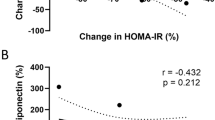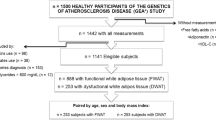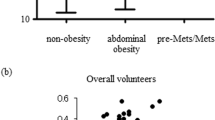Abstract
Objective:
The purpose of this study was to determine the relationships between adipocyte hormones acylation stimulating protein (ASP), adiponectin, complement C3 (C3) (ASP precursor) and insulin, C-reactive protein (CRP), lipid profiles and insulin resistance in lean vs obese type 2 diabetes subjects.
Subjects:
Lean type 2 diabetes subjects (DL n=27) vs obese type 2 diabetes subjects (DO n=55) were compared to age-matched nondiabetic groups (Obese, OB n=55 and control, CTL n=50).
Results:
The DO group demonstrated significant increases in plasma ASP and C3 with decreases in plasma adiponectin as compared to CTL. Interestingly, these increases in ASP and C3 were as high, or greater, in the DL group in spite of normal weight. By contrast adiponectin in the DL group was comparable to CTL, in spite of marked insulin resistance. C3 correlated with insulin, glucose and homeostasis model assessment of insulin resistance (HOMA-IR); ASP correlated with body mass index (BMI), glucose, insulin and plasma lipid parameters (non-esterified fatty acids (NEFA), triglyceride, cholesterol and apolipoprotein B). Adiponectin correlated with BMI, glucose, NEFA, triglyceride, high-density lipoprotein cholesterol and apolipoprotein A1 but not HOMA-IR, ASP or C3. CRP correlated only with HOMA-IR.
Conclusion:
Increased ASP and C3 are both associated with diabetes and related lipid factors but are not regulated coordinately. Adiponectin appears to be more closely related to body size (decreased in obese subjects) than insulin resistance in these subjects.
This is a preview of subscription content, access via your institution
Access options
Subscribe to this journal
Receive 12 print issues and online access
$259.00 per year
only $21.58 per issue
Buy this article
- Purchase on Springer Link
- Instant access to full article PDF
Prices may be subject to local taxes which are calculated during checkout

Similar content being viewed by others
References
Gong D, Yang R, Munir KM, Horenstein RB, Shuldiner AR . New progress in adipocytokine research. Curr Opin Endocrinol Diab 2003; 10: 115–121.
Kalant D, Maslowska M, Scantlebury T, Wang H, Cianflone K . Control of lipogenesis in adipose tissue and the role of acylation stimulating protein. Can J Diab 2003; 27: 154–171.
Jazet IM, Pijl H, Meinders AE . Adipose tissue as an endocrine organ: impact on insulin resistance. Neth J Med 2003; 61: 194–212.
Havel PJ . Control of energy homeostasis and insulin action by adipocyte hormones: leptin, acylation stimulating protein, and adiponectin. Curr Opin Lipidol 2002; 13: 51–59.
Cianflone K, Sniderman AD, Walsh MJ, Vu H, Gagnon J, Rodriguez MA . Purification and characterization of acylation stimulating protein. J Biol Chem 1989; 264: 426–430.
Baldo A, Sniderman AD, St-Luce S, Avramoglu RK, Maslowska M, Hoang B et al. The adipsin-acylation stimulating protein system and regulation of intracellular triglyceride synthesis. J Clin Invest 1993; 92: 1543–1547.
Cianflone K, Xia Z, Chen LY . Critical review of Acylation Stimulating Protein physiology in humans and rodents. Biochim Biophys Acta 2003; 1609: 127–143.
Bhakdi S, Torzewski M, Klouche M, Hemmes M . Complement and atherogenesis: binding of CRP to degraded, nonoxidized LDL enhances complement activation. Arterioscler Thromb Vasc Biol 1999; 19: 2348–2354.
Ebeling P, Teppo AM, Koistinen HA, Koivisto VA . Concentration of the complement activation product, acylation-stimulating protein is related to C-reactive protein in patients with type 2 diabetes. Metabolism 2001; 50: 283–287.
Cianflone K, Roncari DAK, Maslowska M, Baldo A, Forden J, Sniderman AD . The adipsin/acylation stimulating protein system in human adipocytes: regulation of triacylglycerol synthesis. Biochemistry 1994; 33: 9489–9495.
Maslowska M, Scantlebury T, Germinario R, Cianflone K . Acute in vitro production of ASP in differentiated adipocytes. J Lipid Res 1997; 38: 21–31.
Scantlebury T, Maslowska M, Cianflone K . Chylomicron specific enhancement of acylation stimulating protein (ASP) and precursor protein C3 production in differentiated human adipocytes. J Biol Chem 1998; 273: 20903–20909.
Scantlebury T, Sniderman AD, Cianflone K . Retinoic acid regulation of acylation stimulating protein (ASP) and complement C3 in human adipocytes. Biochem J 2001; 356: 445–452.
Cianflone K, Zakarian R, Couillard C, Delplanque B, Despres JP, Sniderman AD . Fasting acylation stimulating protein is predictive of postprandial triglyceride clearance. J Lipid Res 2004; 45: 124–131.
Murray I, Sniderman AD, Cianflone K . Enhanced triglyceride clearance with intraperitoneal human acylation stimulating protein (ASP) in C57Bl/6 mice. Am J Physiol Endocrinol Metab 1999; 277 (Part 1): E474–E480.
Saleh J, Christou N, Cianflone K . Regional specificity of ASP binding in human adipose tissue. Am J Physiol 1999; 276 (Part 1): E815–E821.
Murray I, Sniderman AD, Cianflone K . Mice lacking acylation stimulating protein (ASP) have delayed postprandial triglyceride clearance. J Lipid Res 1999; 40: 1671–1676.
Murray I, Sniderman AD, Havel PJ, Cianflone K . Acylation stimulating protein (ASP) deficiency alters postprandial and adipose tissue metabolism in male mice. J Biol Chem 1999; 274: 36219–36225.
Xia Z, Stanhope KL, Digitale E, Simion O-M, Chen LY, Havel PJ et al. ASP deficiency results in increased energy expenditure in mice. J Biol Chem 2004; 279: 4051–4057.
Murray I, Havel PJ, Sniderman AD, Cianflone K . Reduced body weight, adipose tissue, and leptin levels despite increased energy intake in female mice lacking acylation-stimulating protein. Endocrinology 2000; 141: 1041–1049.
Xia Z, Sniderman AD, Cianflone K . Acylation-stimulating protein (ASP) deficiency induces obesity resistance and increased energy expenditure in ob/ob mice. J Biol Chem 2002; 277: 45874–45879.
Ukkola O, Santaniem M . Adiponectin: a link between excess adiposity and associated comorbidities? J Mol Med 2002; 80: 696–702.
Chan JC, Ng MC, Critchley JA, Lee SC, Cockram CS . Diabetes mellitus – a special medical challenge from a Chinese perspective. Diabetes Res Clin Pract 2001; 54 (Suppl 1): S19–S27.
Zhai F, Fu D, Du S, Ge K, Chen C, Popkin BM . What is China doing in policy-making to push back the negative aspects of the nutrition transition? Public Health Nutr 2003; 5: 269–273.
Ylitalo K, Porkka KV, Meri S, Nuotio I, Suurinkeroinen L, Vakkilainen J et al. Serum complement and familial combined hyperlipidemia. Arteriosclerosis 1997; 129: 271–277.
Ylitalo K, Pajukanta P, Meri S, Cantor RM, Mero-Matikainen N, Vakkilainen J et al. Serum C3 but not plasma acylation-stimulating protein. Is elevated in Finnish patients with familial combined hyperlipidemia. Arterioscler Thromb Vasc Biol 2001; 21: 838–843.
Saleh J, Summers LKM, Cianflone K, Fielding BA, Sniderman AD, Frayn KN . Coordinated release of acylation stimulating protein (ASP) and triacylglycerol clearance by human adipose tissue in vivo in the postprandial period. J Lipid Res 1998; 39: 884–891.
Kalant D, Phelis S, Fielding BA, Frayn KN, Cianflone K, Sniderman AD . Increased postprandial fatty acid trapping in subcutaneous adipose tissue in obese women. J Lipid Res 2000; 41: 1963–1968.
Matthews DR, Hosker JP, Rudenski AS, Naylor BA, Treacher DF, Turner RC . Homeostasis model assessment: insulin resistance and beta-cell function from fasting plasma glucose and insulin concentrations in man. Diabetologia 1985; 28: 412–419.
Friedewald WT, Levy RI, Fredrickson DS . Estimation of the concentration of low-density lipoprotein cholesterol in plasma, without use of the preparative ultracentrifuge. Clin Chem 1972; 18: 499–502.
World Health Organization Expert Committee. Second report on diabetes mellitus, (Technical Report Series), World Health Organization: Geneva, Switzerland, 1980, pp. 646–651.
World Health Organization. The Asia–Pacific Perspective: Redefining obesity and its treatment. World Health Organization: Geneva, Switzerland, 2000.
Kotler DP, Ionescu G, Johnson JA, Inada Y, He Q, Engelson ES et al. Studies of adipose tissue metabolism in human immunodeficiency virus-associated lipodystrophy. Clin Infect Dis 2003; 37 (Suppl 2): S47–S51.
Faraj M, Havel PJ, Phelis S, Blank D, Sniderman AD, Cianflone K . Plasma acylation-stimulating protein, adiponectin, leptin, and ghrelin before and after weight loss induced by gastric bypass surgery in morbidly obese subjects. J Clin Endocrinol Metab 2003; 88: 1594–1602.
Lindsay RS, Funahashi T, Hanson RL, Matsuzawa Y, Tanaka S, Tataranni PA et al. Adiponectin and development of type 2 diabetes in the Pima Indian population. Lancet 2002; 360: 57–58.
Spranger J, Kroke A, Mohlig M, Bergmann MM, Ristow M, Boeing H et al. Adiponectin and protection against type 2 diabetes mellitus. Lancet 2003; 361: 226–228.
Yang WS, Jeng CY, Wu TJ, Tanaka S, Funahashi T, Matsuzawa Y et al. Synthetic peroxisome proliferator-activated receptor-gamma agonist, rosiglitazone, increases plasma levels of adiponectin in type 2 diabetic patients. Diabetes Care 2002; 25: 376–380.
Hotta K, Funahashi T, Arita Y, Takahashi M, Matsuda M, Okamoto Y et al. Plasma concentrations of a novel, adipose-specific protein, adiponectin, in type 2 diabetic patients. Arterioscler Throm Vasc Biol 2000; 20: 1595–1599.
Yatagai T, Nagasaka S, Taniguchi A, Fukushima M, Nakamura T, Kuroe A et al. Hypoadiponectinemia is associated with visceral fat accumulation and insulin resistance in Japanese men with type 2 diabetes mellitus. Metabolism 2003; 52: 1274–1278.
Zietz B, Herfarth H, Paul G, Ehling A, Muller-Ladner U, Scholmerich J et al. Adiponectin represents an independent cardiovascular risk factor predicting serum HDL-cholesterol levels in type 2 diabetes. FEBS Lett 2003; 545: 103–104.
Pellme F, Smith U, Funahashi T, Matsuzawa Y, Brekke H, Wiklund O et al. Circulating adiponectin levels are reduced in nonobese but insulin-resistant first-degree relatives of type 2 diabetic patients. Diabetes 2003; 52: 1182–1186.
Valsamakis G, Chetty R, McTerman PG, Al-Daghri NM, Barnett AH, Kumar S . Fasting serum adiponectin concentration is reduced in Indo-Asian subjects and is related to HDL cholesterol. Diabetes Obes Metab 2003; 5: 131–135.
Tschritter O, Fritsche A, Thamer C, Haap M, Shirkavand F, Rahe S et al. Plasma adiponectin concentrations predict insulin sensitivity of both glucose and lipid metabolism. Diabetes 2003; 52: 239–243.
Yang WS, Lee WJ, Funahashi T, Tanaka S, Matsuzawa Y, Chao CL et al. Plasma adiponectin levels in overweight and obese Asians. Obes Res 2002; 10: 1104–1110.
Yamamoto Y, Hirose H, Saito I, Tomita M, Taniyama M, Matsubara K et al. Correlation of the adipocyte-derived protein adiponectin with insulin resistance index and serum high-density lipoprotein-cholesterol, independent of body mass index, in the Japanese population. Clin Sci (London) 2002; 103: 137–142.
Haque WA, Shimomura I, Matsuzawa Y, Garg A . Serum adiponectin and leptin levels in patients with lipodystrophies. J Clin Endocrinol Metab 2002; 87: 2395.
Yang WS, Lee WJ, Funahashi T, Tanaka S, Matsuzawa Y, Chao CL et al. Weight reduction increases plasma levels of an adipose-derived anti-inflammatory protein, adiponectin. J Clin Endocrinol Metab 2001; 86: 3815–3819.
Yamauchi T, Kamon J, Ito Y, Tsuchida A, Yokomizo T, Kita S et al. Cloning of adiponectin receptors that mediate antidiabetic metabolic effects. Nature 2003; 423: 762–769.
Koistinen HA, Vidal H, Karonen SL, Dusserre E, Vallier P, Koivisto VA . Plasma acylation stimulating protein concentration and subcutaneous adipose tissue C3 mRNA expression in nondiabetic and type 2 diabetic men. Arterioscler Throm Vasc Biol 2001; 21: 1034–1039.
Weyer C, Tataranni PA, Pratley RE . Insulin action and insulinemia are closely related to the fasting complement C3, but not acylation stimulating protein concentration. Diabetes Care 2000; 23: 779–785.
Pomeroy C, Mitchell J, Eckert E, Raymond N, Crosby R, Dalmasso AP . Effect of body weight and calorie restriction on serum complement proteins, including Factor D/adipsin: studies in anorexia nervosa and obesity. Clin Exp Immunol 1997; 108: 507–515.
Mantov S, Raev D . Addictive effect of diabetes and systemic hypertension on the immune mechanisms of atherosclerosis. Int J Cardiol 1996; 56: 145–148.
Figueredo A, Ibarra JL, Bagazgoitia J, Rodriguez A, Molino AM, Fernandez-Cruz A et al. Plasma C3d levels and ischemic heart disease in type II diabetes. Diabetes Care 1993; 16: 445–449.
Muscari A, Massarelli G, Bastagli L, Poggiopollini G, Tomassetti V, Volta U et al. Relationship between serum C3 levels and traditional risk factors for myocardial infarction. Acta Cardiol 1998; 53: 345–354.
Pickup JC, Crook MA . Is type II diabetes mellitus a disease of the innate immune system? Diabetologia 1998; 41: 1241–1248.
Pickup JC, Mattock MB, Chusney GD, Burt D . NIDDM as a disease of the innate immune system: association of acute-phase reactants and interleukin-6 with metabolic syndrome X. Diabetologia 1997; 40: 1286–1292.
Rajala MW, Scherer PE . Minireview: the adipocyte – at the crossroads of energy homeostasis, inflammation, and atherosclerosis. Endocrinology 2003; 144: 3765–3773.
Lyon CJ, Law RE, Hsueh WA . Minireview: adiposity, inflammation, and atherogenesis. Endocrinology 2003; 144: 2195–2200.
Hotamisligil GS, Spiegelman BM . Tumor necrosis factor α: a key component of the obesity–diabetes link. Diabetes 1994; 43: 1271–1278.
Charlesworth JA, Peake PW, Campbell LV, Pussell BA, O'Grady S, Tzilopoulos T . The influence of oral lipid loads on acylation stimulating protein (ASP) in healthy volunteers. Int J Obesity Rel Metab Disord 1998; 22: 1096–1102.
Germinario R, Sniderman AD, Manuel S, Pratt S, Baldo A, Cianflone K . Coordinate regulation of triacylglycerol synthesis and glucose transport by acylation stimulating protein. Metabolism 1993; 42: 574–580.
Tao Y, Cianflone K, Sniderman AD, Colby-Germinario SP, Germinario RJ . Acylation-stimulating protein (ASP) regulates glucose transport in the rat L6 muscle cell line. Biochim Biophys Acta 1997; 1344: 221–229.
Maslowska M, Sniderman AD, Germinario R, Cianflone K . ASP stimulates glucose transport in cultured human adipocytes. Int J Obesity Rel Metab Dis 1997; 21: 261–266.
Ahren B, Havel PJ, Pacini G, Cianflone K . Acylation stimulating protein stimulates insulin secretion. Int J Obesity Rel Metab Disord 2003; 27: 1037–1043.
Ozata M, Gungor D, Turan M, Ozisik G, Bingol N, Ozgurtas T et al. Improved glycemic control increases fasting plasma acylation-stimulating protein and decreases leptin concentrations in type II diabetic subjects. J Clin Endocrinol Metab 2001; 86: 3659–3664.
Ozata M, Ortenli C, Culec M, Ozgurtas T, Bulucu F, Caglar R et al. Increased fasting plasma acylation-stimulating protein concentrations in nephrotic syndrome. J Clin Endocrinol Metab 2002; 87: 853–858.
Halkes CJM, Kijk HV, de Jaegere PPT, Plokker HWM, Van der Helm Y, Erkelens DW et al. Postprandial increase of complement component 3 in normolipidemic patients with coronary artery disease effects of expanded-dose simvastatin. Arterioscler Throm Vasc Biol 2001; 21: 1526–1530.
Zhang XJ, Cianflone K, Genest J, Sniderman AD . Plasma acylation stimulating protein (ASP) as a predictor of impaired cellular biological response to ASP in patients with hyperapoB. Eur J Clin Invest 1998; 28: 730–739.
Sniderman AD, Cianflone K . Metabolic disruptions in the adipocyte–hepatocyte fatty acid axis as causes of hyperapoB. Int J Obesity Rel Metab Disord 1995; 19 (Suppl 1): S27–S33.
Kalant D, Cain SA, Maslowska M, Sniderman AD, Cianflone K, Monk PN . The chemoattractant receptor-like protein C5L2 binds the C3a des-Arg77/acylation-stimulating protein. J Biol Chem 2003; 278: 11123–11129.
Acknowledgements
This study was supported by Grant # OOP69600 from CIHR (to KC) and the FRSQ-NSFC Quebec–China exchange program (to KC). KC is Canada Research Chair in Adipose Tissue. We acknowledge the contribution of the Laboratory of Endocrinology and the Laboratory of Pediatrics, Tongji Hospital, Tongji Medical College, Huazhong University of Science and Technology for supporting this work. We thank Lin Feng, Feng Xiao and Jun Wei for technical assistance and for their help in recruiting the subjects. Ping Yin provided statistical advice.
Author information
Authors and Affiliations
Corresponding author
Rights and permissions
About this article
Cite this article
Yang, Y., Lu, H., Zhang, J. et al. Relationships among acylation stimulating protein, adiponectin and complement C3 in lean vs obese type 2 diabetes. Int J Obes 30, 439–446 (2006). https://doi.org/10.1038/sj.ijo.0803173
Received:
Revised:
Accepted:
Published:
Issue Date:
DOI: https://doi.org/10.1038/sj.ijo.0803173
Keywords
This article is cited by
-
Plant-based dietary indices and biomarkers of chronic low-grade inflammation: a cross-sectional analysis of adults in Ireland
European Journal of Nutrition (2023)
-
Maternal serum proteomic profiles of pregnant women with type 1 diabetes
Scientific Reports (2022)
-
Vertical Paper Analytical Devices Fabricated Using the Principles of Quilling and Kirigami
Scientific Reports (2017)
-
The role of complement system in adipose tissue-related inflammation
Immunologic Research (2016)
-
Serum Adipsin Levels throughout Normal Pregnancy and Preeclampsia
Scientific Reports (2016)



